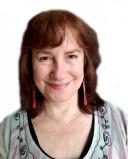Child Development
How to Write for Children Without Injuring Your Brain
Writing for children is not a choice, it's a voice.
Posted April 3, 2011

British author Martin Amis, in his usual adorable self-depreciating way, recently managed to insult a great many children and those who write for children. He is quoted as having said (on the BBC's book program Faulks on Fiction):
"If I had a serious brain injury I might well write a children's book, but otherwise the idea of being conscious of who you're directing the story to is anathema to me, because, in my view, fiction is freedom and any restraints on that are intolerable."
Putting his hyperbole aside (and leaving his point about freedom from restraints for a future blog post), I decided to interview a talented author of children's books, Joanne Rocklin.
Rocklin's latest is One Day and One Amazing Morning on Orange Street (Abrams/Amulet). (Her advice on what NOT to do in writing for children will appear in my next post.)
WHY WRITE FOR KIDS
Q: Why do smart sophisticated writers like yourself choose to write for young people?
A. In my opinion, writing for children is not a choice. It is simply the voice, inclination, temperament, talent and background of a particular writer that influences the result. Why do some writers write mysteries, others write romance novels for adults, etc., etc.?
I feel that I have a particular talent for this, and can easily access the voice of a child, especially the middle grader (7 through 12.) Those years were very fruitful for me as a writer and reader. At that age I read voraciously, haunting my local library, and kept a diary. I wrote endless letters during the summers, letters which my best friend and I exchanged when the summer was over. I still have them! The thoughts and feelings of a middle grader are burned inside my brain.
Also, my entire life has been focused on kids, having been an elementary school teacher, clinical psychologist working with families, mother, grandmom. As well as remembering my own childhood vividly, I am sensitive to and deeply fascinated by the children in my life. The children in ONE DAY AND ONE AMAZING MORNING ON ORANGE STREET each have a particular worry and stance on life which I understand and remember. In my novel there are anxieties about family illness, a new sibling, divorce, the safety of the adults in their lives. But there is also humor, and the solace of friendship, role models, nature, and community.
Another reason is, simply, that I love children's literature. There are some beautiful, brilliant, absorbing, funny, moving books out there, quite different from much of the children's literature of the old days. There are specific genres and styles for each stage of childhood. It is actually "smart sophisticated writers", as you put it, who are children's authors. The ones who are ignorant about the literature and naive about its depth will never get published.
.jpg) Q. What are the particular challenges of writing for a young audience?
Q. What are the particular challenges of writing for a young audience?
A. The challenges of writing for kids are the same as that for every writer: finding a voice that's authentic and accessible and interesting; creating characters that come alive on the page; writing a plot that excites; and expressing themes and issues that touch readers.
A main difference, however, is the challenge of understanding how the form of the book relates to the age of the reader. Picture books are created for specific ages and their specific childhood issues, as do early readers, middle grades, and young adult novels. The main character in a children's book is usually approximately the age of the reader of those books. Ali, Bunny, Robert and Leandra, the characters in my latest novel, are all around the same age, eight through twelve. I haven't always specified their exact ages, but their thoughts and feelings and dialogue are representative.
Another challenge is stifling your didactic tendency. The main purpose of your book is to entertain, and to get kids to love reading. Unless you are writing a nonfiction book, the teaching and any moral "lesson" that results is not the focus, or even necessarily apparent.
THE GOOSEBUMP FACTOR
Q: One Day and One Amazing Morning gave me little goosebumps at the end. Is that something you feel you can make happen whenever you want to? Do you get those thrills yourself when you re-read your own work?
A. Are you kidding? Wouldn't it be wonderful to have all one's drafts "goosebump assured"! I certainly try, though, and when it happens, it's such a wonderful feeling. Yes, I do get those thrills in rereading my own work, at those specific parts. Sometimes I can engineer it, but only if I'm already deeply involved with the character and the project. Often I'm completely surprised.
I really think that's what keeps writers going, hoping for that experience once again. And one must, must, must have faith that it will happen. I've found that if I continue forging ahead, rewriting, immersing myself in the work, it usually will. Also, a goosebump moment in my books usually occurs at the very end, as it did in ONE DAY AND ONE AMAZING MORNING ON ORANGE STREET. That last paragraph is incredibly meaningful to me, personally, in my own life: the importance of cherishing the beauties of the present moment. I usually know my last paragraph before I get to the middle of my book, and am always writing towards it. It's the goosebumpy culmination of everything I've written until then. I can't WAIT to be able to write it, and sometimes I write it before the end, just for the experience.
Q: Who's your ideal audience? Do you picture your own kids or their kids as you write?
A. That's so hard to answer! I think I'm writing for the reader I once was at a certain age, and youngsters I've known. But--once the story starts rolling, I am writing only for the story and character--what makes sense to the plot, what the character herself would do in various situations, who has become real to me. It's very important to be true to the character, and I don't think about the audience or myself as much at that point.
FLOW AND REVISION
Q: Do you enter flow, when time seems to stop? How much revising do you do?
A. Ah, flow! As I said above, that's probably the reason for writing! I do many drafts of my story. I scribble things to myself in the margins and the first page of the manuscript, but usually don't revise until I've written the whole draft. I just forge ahead until the end. My first draft is very, very messy, and I love when it is. It means the ideas are percolating and I'm getting more and more of them. Sometimes I don't know what the beginning is like until I've written more of my story, but I can't stop to make it "perfect" or I'll never move forward.
Each of my drafts is written using a different color of paper. That's probably a psychological trick, to make me feel as if I'm progressing! I've found Anne Lamott's concept of the awful first draft very liberating, as well as the UP and DOWN concept of writing: Get it DOWN, then fix it UP. Children are sticklers for errors, and always, always find them. All children's authors get letters from young critics.
Q: Strudel Stories is delightful, in concept and execution. Did it do well in the marketplace?
A. It was not a bestseller, but it was an American Library Association Notable book, and I still get letters about it. Sadly, it's out of print, but I love that book. FOR YOUR EYES ONLY! is doing well, especially as an audiobook.
- Read Joanne's blog.
- Don't miss this post featuring Joanne Rocklin's advice: 8 Ways NOT to Write for Children.
Copyright (c) 2011 by Susan K. Perry.




